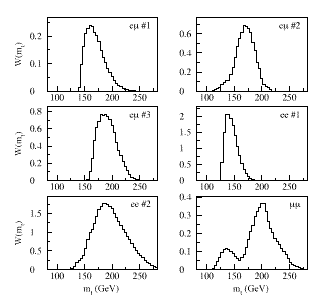
This page gives details of my thoughts on a 136.7 GeV ground state.
The D4-D5-E6 model predicts a Truth Quark mass of about 130 GeV, as does the discrete HyperDiamond Feynman Checkerboard model.
From the 1997 UC Berkeley PhD thesis of Erich Ward Varnes: "... the measurement using dilepton events is less sensitive to [the vagaries of non-perturbative QCD (in particular as they relate to the understanding of the jet energy scale)] than that using lepton plus jet events. ..."
I think that the DILEPTON EVENT MASS should be considered PRIMARY INPUT, with the SEMILEPTONIC EVENT DATA variances from the DILEPTON MASS plus BACKGROUND MODELS being used to study the Background Models and correct their deficiencies with respect to complicated electroweak and QCD phenomena.
D0 August 1998 and D0 June 1997 has analyzed 6 Dilepton events from over 100 pb^(-1) of events from the 1992-1996 run at 1.8 TeV of the Fermilab Tevatron. The next run of the Tevatron is planned to begin in 1999, with instantaneous luminosity increased by an order of magnitude, upgrades for both D0 and CDF detectors, and energy increased to 2.0 TeV. Until then, there are 6 interesting Dilepton events from the 1992-1996 run whose analysis sheds some light on the mass of the Truth quark. Details of the events, and the D0 analysis of the events, are in the 1997 UC Berkeley PhD thesis of Erich Ward Varnes. Its details make it more useful to me than D0 August 1998 and D0 June 1997 which concludes from its analysis of all 6 Dilepton events that the Truth quark mass is 168.4 +/- 12.3 (stat) +/- 3.7 (sys) GeV. Since there are only 6 Dilepton events, I prefer to look at each of them in some detail, based on data from the Varnes thesis, and draw my own conclusions, which I think support the D4-D5-E6 model and HyperDiamond Feynman Checkerboard model predictions of a Truth quark mass of about 130 GeV.
D0 August 1998 presented Truth quark mass likelihood plots for the 6 events, calculated by two different methods.
First, D0 August 1998 presented plots by the matrix-element weighting algorithm that "... is an extension of the weight proposed in [R.H. Dalitz and G.R. Goldstein, Phys. Rev. D45, 1531 (1992)] ...".

Note the small peak on the muon-muon event at about 140 GeV. As will be seen from the Varnes thesis, that event (as well as events e-e#2 and e-muon#2) had 3 jets instead of the 2 jets that you would normally expect in a Dilepton event. In my analysis, I used 2 jets rather than 3.
Second, D0 August 1998 presented plots by the neutrino weighting algorithm
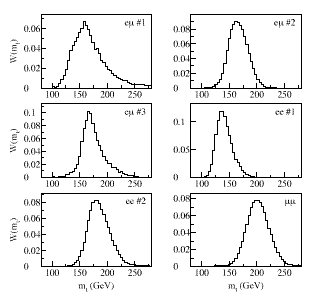
As will be seen from the Varnes thesis, events muon-muon, e-e#2, and e-muon#2 had 3 jets instead of the 2 jets that you would normally expect in a Dilepton event. In my analysis, I used 2 jets rather than 3.
Here, from page 159 of the Varnes thesis, are Truth quark mass likelihood plots for 5 of the 6 events calculated by the neutrino weighting algorithm: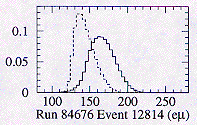
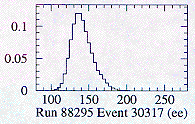
In some cases, there were 3 jets instead of the 2 jets you would normally expect in a Dilepton event. In those cases, the solid line is the plot if all 3 jets are included, and the dashed line is the plot if only 2 of the jets are included by excluding the third (lowest transverse energy) jet.
The 6th event, Run 95653 Event 10822 (denoted by D0 as e-e#2), was added to the data base by D0 even though it failed to pass event selection. To put this event in the data base, D0 had to change its interpretation of one EM cluster from photon to electron, on the basis of muon tagging of the EM cluster. Here, from page 159 of the Varnes thesis, is its Truth quark mass likelihood plot calculated by the neutrino weighting algorithm:This event had 3 jets, not just 2, so the solid line is the plot if all 3 jets are included, and the dashed line is the plot if only 2 of the jets are included by excluding the third (lowest transverse energy) jet.
If all 6 events are averaged, with all 3 jets included in the 3 jet events, the result is (160+165+170+135+165+180)/6 = 168.3 GeV, which is substantially the result of the D0 analysis.
Analysis of events is to some degree a matter of taste. The D0 June 1997 analysis of 6 events, with 3 jets included in 3 jet events, reflects the taste of D0 June 1997. Analysis by D0 June 1997 gives a T-Quark mass of 168.3 GeV. The D0 August 1998 analysis of 6 events is based on the following statements from Section VI.C. of their paper:
"... The fragmentation of a b quark can produce more than one jet because of hard gluon radiation. This corresponds to final state radiation. Jets can also originate from gluons radiated by partons in the initial state. We refer to this as initial state radiation. We assign two of them to the b quarks and the third jet either to initial state radiation, in which case we ignore it, or to final state radiation, in which case we add its momentum to that of one of the two b quarks. There are six possible permutations for three jets, as listed in Table V. If there is a jet in the event that is tagged by a soft muon, we only allow permutations that assign this jet to a b quark. In the collider data sample this is the case for one ee event [event e-e#2]. ... Not all permutations are equally likely to be correct. ... The numerical coefficients of the exponents are chosen such that the mean reconstructed top quark masses for events with two-jet and multi-jet final states are the same. ... After adding the four-momenta of the jets assigned to a b quark, we rescale the mo mentum components, keeping the energy fixed, so that the b quark four-momentum has an invariant mass of 5 GeV to put the outgoing quark momentum on the mass shell. There are two ways to pair the momenta of the two charged leptons with the two b quark momenta. Since we cannot determine which b quark originated from the decay of the t quark and which from the decay of the [ t anti-quark], we consider both pairings with equal probability. ..."
Analysis by D0 August 1998 gives a T-Quark mass of 168.4 GeV.
My taste is somewhat different: First I exclude Run 95653 Event 10822 (denoted by D0 as e-e#2) because it failed to pass event selection. Second I do not include all 3 jets in the 3 jet events because I think that Dilepton events should have 2 jets. Those two changes give the result (160+135+170+135+165)/5 = 153 GeV. Third I look at the shape of the plots and notice that 3 of the 5 plots have a nice shape, narrow peaks rising steeply from lower energies as the threshold energy is approached, while 2 of the 5 (Run 58796 Event 417 and Run 84395 Event 15530) are somewhat broader peaks rising with a shoulder, not so steeply, as the threshhold energy is approached. Therefore I exclude Run 58796 Event 417 and Run 84395 Event 15530 (denoted by D0 as e-muon#1 and muon-muon). All three of my changes give the result (135+170+135)/3 = 146.7 GeV.
Note that the double-hump structure of the D0 matrix-element plot of the muon-muon event
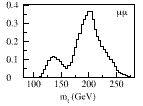
sugggests that if I retained the muon-nuon event as a 2-jet event, throwing out one of the higher-energy jets rather than the lowest energy jet, I might get a Truth Quark mass of about 140 GeV for the muon-muon event.
After reducing my sample to 3 events with 2 jets each (denoted by D0 as e-e#1, e-muon#2, and e-muon#3), with average energy = (135+170+135)/3 = 146.7 GeV, I notice that Section 8.1.1 of the Varnes thesis says that the Monte Carlo ensemble tests used by D0 give substantial differences between the maximum likelihood masses and the known Monte Carlo mass in the energy range from 130 to 150 GeV leading to a loss of sensitivity of the likelihood fit in that range, and that the D0 analysis is self-consistent only if the result exceeds 150 GeV.
D0 August 1998 acknowledges this phenomenon, saying "... The differences between [the maximum likelihood estimate and the Monte Carlo] at masses below 150 GeV can be traced to the small number of events available to model some of the backgrounds [ Z to ll, WW ]. For these background processes the selection efficiency is so low that a significant increase in the number of Monte Carlo events that satisfy the selection criteria is not possible due to limited computing resources. When we replace these small samples with large samples picked randomly from a smooth distribution these differences vanish. For fitted masses above about 150 GeV, these differences become small. We choose not to correct the results for this effect. It is included in the uncertainty assigned to the fit procedure in Sect. VIII F. ..."
For the matrix-element weighting algorithm, a panel of Figure 18 of D0 August 1998 shows the discrepancy as

For the neutrino weighting algorithm, a panel of Figure 18 of D0 August 1998, which appears to be the panel of Figure 8.2 of the Varnes thesis that is shown immediately belowappears to me to show that the D0 maximum likelihood mass (using the neutrino weighting algorithm) in the 140 GeV range overstates the Truth quark mass by about 10 GeV. Therefore, I reduce the value of 146.7 GeV for my 3 events by 10 GeV. This reduction gives the final result of my analysis, a Dilepton Truth quark mass of 136.7 GeV. My result of 136.7 GeV is reasonably close to the 130 GeV prediction of the D4-D5-E6 model and HyperDiamond Feynman Checkerboard model.
Here are the Kinematics of the 6 D0 Dilepton events, from Appendix B.2 of the 1997 UC Berkeley PhD thesis of Erich Ward Varnes.
(Similar kinematic data are presented in D0 August 1998.)
In the Varnes Kinematics tables, there are two numbers for each jet: one is energy after CAFIX corrections; and the second (in parentheses) is energy after post-CAFIX corrections.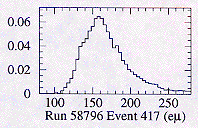
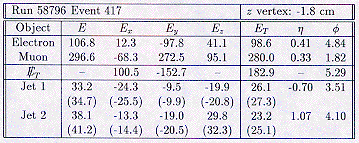

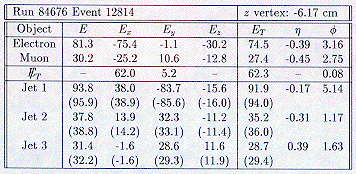
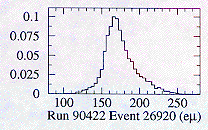
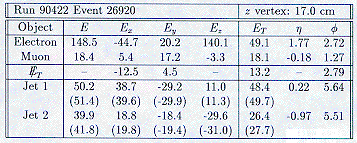

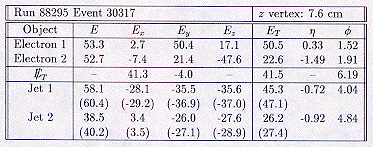
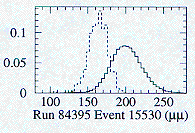
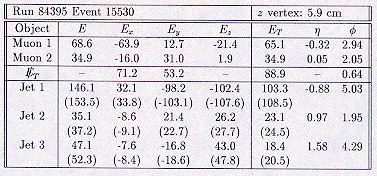
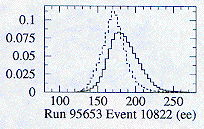

Here is some 1984-1992 history of the Truth Quark.
......